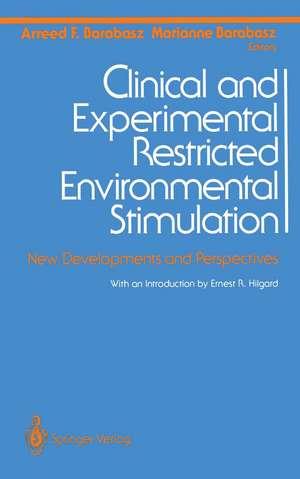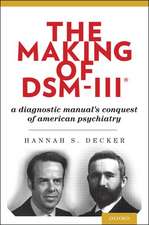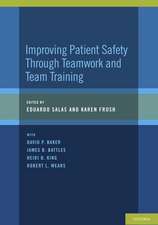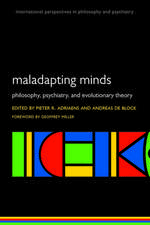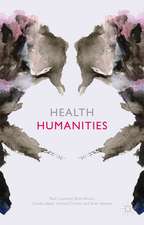Clinical and Experimental Restricted Environmental Stimulation: New Developments and Perspectives
Editat de Arreed F. Barabasz Introducere de E.R. Hilgard Editat de Marianne Barabaszen Limba Engleză Paperback – 26 noi 2012
Preț: 391.61 lei
Nou
Puncte Express: 587
Preț estimativ în valută:
74.96€ • 81.45$ • 63.01£
74.96€ • 81.45$ • 63.01£
Carte tipărită la comandă
Livrare economică 21 aprilie-05 mai
Preluare comenzi: 021 569.72.76
Specificații
ISBN-13: 9781468485851
ISBN-10: 1468485857
Pagini: 356
Ilustrații: XVII, 336 p. 11 illus.
Dimensiuni: 155 x 235 x 19 mm
Greutate: 0.5 kg
Ediția:Softcover reprint of the original 1st ed. 1993
Editura: Springer
Colecția Springer
Locul publicării:New York, NY, United States
ISBN-10: 1468485857
Pagini: 356
Ilustrații: XVII, 336 p. 11 illus.
Dimensiuni: 155 x 235 x 19 mm
Greutate: 0.5 kg
Ediția:Softcover reprint of the original 1st ed. 1993
Editura: Springer
Colecția Springer
Locul publicării:New York, NY, United States
Public țintă
ResearchCuprins
I. New Theoretical Developments and Perspectives for Clinical Practice.- 1. Stimulus and Theoretical Reductionism: What Underlies REST Effects?.- 2. A Neo-Dissociation Conceptualization of REST.- 3. Bridging the Gap.- 4. Temporal Patterns of Affect in an Isolated Group.- II: Sensory Restriction and Hypnotizability.- 5. Neo-Dissociation Accounts for Pain Relief and Hypnotic Susceptibility Findings: Flotation REST Elicits Hypnosis.- 6. REST and Hypnotic Phenomena: Some Similarities Observed in European Case Studies.- 7. A Model of the Common “Active Ingredient” in Stress Reduction Techniques.- 8. Age Regression Phenomena.- Section III. Enhancement of Performance.- 9. Effects of Flotation REST and Visual Imagery on Athletic Performance: Tennis.- 10. Flotation REST and Imagery in the Improvement of Collegiate Athletic Performance: Basketball.- 11. Short-Term Exposure to REST: Enhanced Performance on a Signal-Detection Task.- Section IV. Stress Management.- 12. Slow REST or Fast Drugs: Meditation or Medication?.- 13. Effects of Chamber REST, Flotation REST and Relaxation on Transient Mood State.- Section V. Treatment of Habit Disorders.- 14. REST: A Key Facilitator in the Treatment of Eating Disorders.- 15. Twenty-Four Hours of Chamber REST Produces Specific Food Aversions in Obese Females.- 16. Treatment of Trichotillomania and Smoking with Hypnosis and REST.- 17. Motivational Factors in Alcohol Consumption: Extending Hull’s Model.- 18. Chamber REST Reduces Alcohol Consumption: 3, 6, 12, and 24 Hour Sessions.- Section VI. Psychophysiological Effects.- 19. Psychophysiological Comparisons of REST and Hypnosis: Implications for Future Research.- 20. REST in the Treatment of Persistent Psychophysiological Insomnia.- 21. Differential Effects of Wet and Dry Flotation RESTon EEG Frequency and Amplitude.- Section VII. Biological Effects.- 22. The Physiological Effects of Flotation REST.- 23. Effects of Flotation REST on the Immune Response: T-Cells, B-Cells, Helper and Suppressor Cells.- 24. Effects of Wet and Dry Flotation REST on Blood Pressure and Plasma Cortisol.- 25. Relaxed and Alert: Patterns of T-Wave Amplitude and Heart Rate in a REST Environment.- 26. A Method for Continuous Blood Sampling During Flotation REST.- Section VIII. Treatment of Physical Dysfunctions and Psychological Disorders.- 27. REST as a Treatment for Children with Autism.- 28. The Effects of Consecutive Floats and Their Timing on Premenstrual Syndrome.- 29. Flotation REST, Physical Therapy and Psychological Intervention in the Treatment of Physical Disabilities.- 30. Effects of Flotation REST on Range of Motion, Grip Strength and Pain in Rheumatoid Arthritics.- Section IX. References.
